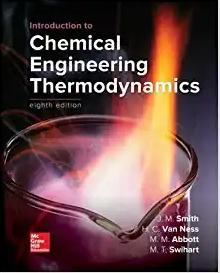Exercise 3.6 Temperature Dependence of Rate Constant The first order isomerization reaction, cyclopropane propene, has a rate constant of 1.10*10-4 s-1 at 400oC and activation energy of 264kJ/mol. What is the temperature of the reaction when the rate constant is equal to 4.36103s1 ? Exercise 3.7 Activation Energy and Rate Constant for a Reversible Reaction Consider an elementary reversible reaction of the form A+BCAB+C. The forward rate constant is measured to be 2.0 L/mol-s at 45oC and 4.3L/mols at 75oC. The reaction is exothermic with 40kJ/mol of A reacted. a) What is the activation energy for the forward reaction? b) Suppose that when an equimolar mixture of A and BC is used as the feed, the equilibrium conversion is 75% at 45 oC. What is the rate constant for the reverse reaction at 45 oC? Exercise 4.1: CSTR Design Using Damkhler Number (Da) The elementary reversible reaction A+B2C occurs in the liquid phase in an isothermal CSTR. A stream containing the equimolar amount of A and B in a solvent enters the reactor, and the conversion of A is measured to be 60%. The equilibrium conversion of A under the same inlet conditions is known to be 80%. The volumetric flow rate into the process is to be increased by a factor of 1.5, with the inlet concentrations of A and B and the temperature remaining constant. What is the new conversion of A ? Exercise 4.2: PFR Design Using Damkhler Number The elementary irreversible reaction A+B C is conducted in the gas-phase in an isothermal PFR. The feed enters the reactor at a pressure of 10 bar and temperature of 600K, and consists of 30%A,30%B, and 40% inert. The conversion of A in exiting PFR is measured to be 50%. By what factor should the PFR volume used for this process be increased to achieve a conversion of 75% if there is no change in the feed stream? Exercise 4.3 Effect of Stoichiometry in Gas-Phase Reaction An elementary reversible gas-phase reaction 2A+BC is being conducted in an isothermal PFR. The conversion of the limiting reactant is 75%. The process temperature and pressure are 500K and 8atm, respectively, and the feed consist of 40% A and 60% B. What is the outlet concentration of A? Assume ideal gas conditions







